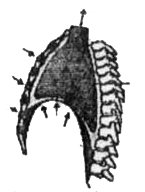Which of the following does not form during glycolysis?
NADH
ATP
Pyruvate
FADH2
The correct Answer is:D
Step-by-Step Solution:
1. Understand Glycolysis: Glycolysis is the metabolic process that breaks down glucose into two molecules of pyruvate. It is the first step in cellular respiration.
2. Identify Products of Glycolysis: During glycolysis, several key products are formed:
- Two molecules of pyruvate
- ATP (adenosine triphosphate)
- NADH (nicotinamide adenine dinucleotide)
3. Analyze the Options: The question asks which of the following does not form during glycolysis. The options typically include:
- NADH
- ATP
- Pyruvate
- FADH2
4. Determine the Incorrect Option:
- NADH, ATP, and pyruvate are all products of glycolysis.
- FADH2 is not produced during glycolysis; it is formed during the Krebs cycle (also known as the citric acid cycle).
5. Conclude the Answer: Therefore, the correct answer to the question "Which of the following does not form during glycolysis?" is FADH2.
Final Answer: FADH2 (Option D)
---
- Two molecules of pyruvate
- ATP (adenosine triphosphate)
- NADH (nicotinamide adenine dinucleotide)
- NADH
- ATP
- Pyruvate
- FADH2
- NADH, ATP, and pyruvate are all products of glycolysis.
- FADH2 is not produced during glycolysis; it is formed during the Krebs cycle (also known as the citric acid cycle).
Topper's Solved these Questions
- BOOK - ICSECHAPTER - RESPIRATION IN PLANTSEXERCISE - TEST YOUR PROGRESS ( OBJECTIVE TYPE QUESTIONS ) (Fill in the blanks with appropriate words.)8videos
RESPIRATION IN PLANTS
- BOOK - ICSECHAPTER - RESPIRATION IN PLANTSEXERCISE - TEST YOUR PROGRESS ( OBJECTIVE TYPE QUESTIONS ) (State whether the following statements are true or false .)22videos
RESPIRATION IN PLANTS
- BOOK - ICSECHAPTER - QUESTION PAPER -BIOLOGYEXERCISE - PART -II (Section -C)6videos
QUESTION PAPER -BIOLOGY
- BOOK - ICSECHAPTER - SAMPLE QUESTION PAPER 2 EXERCISE - PART-II SECTION - C6videos
SAMPLE QUESTION PAPER 2
Similar Questions
Knowledge Check
- Question 1 - Select One
Which of the following does not form M^(+3)?
AA)BBB)AICC)GaDD)In - Question 2 - Select One
Which of the following steps during glycolysis is associated with utilisation of ATP?
AGlucose → Glucose -6-phosphateBFructose-6-phosphate → Fructose-1,6-biphosphateCPEP → Pyruvic acidDBoth (a) and (b)
Which of the following does not occur during breathing?
View SolutionWhich of the following is correct regarding glycolysis ?
View SolutionWhich of the following oxide does not form dimer?
View SolutionWhich of the following does not occur during the stage of ventilation depicted in the following diagram?
 View Solution
View SolutionWhich of the following reactions does not occur during calcination?
View SolutionWhich of the following reactions does not occur during calcination?
View Solution

